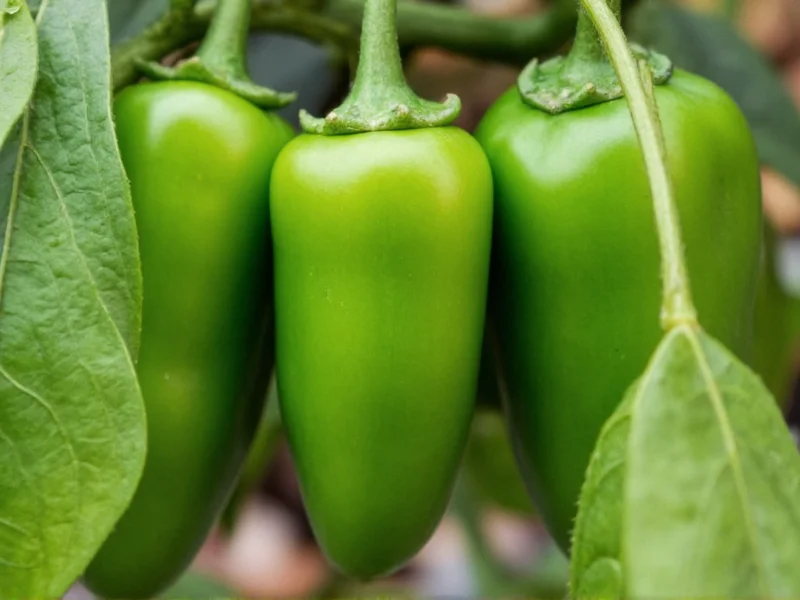Understanding the precise heat level of jalapeños helps home cooks, chefs, and spice enthusiasts accurately gauge what to expect when using these popular peppers. The Scoville scale, developed by pharmacist Wilbur Scoville in 1912, remains the standard measurement for pepper heat intensity despite newer laboratory methods.
What Are Scoville Heat Units?
Scoville Heat Units measure the pungency or spiciness of chili peppers and other spicy foods. The scale works by diluting pepper extract in sugar water until the heat becomes undetectable to a panel of tasters. The degree of dilution determines the Scoville rating. For example, a pepper rated at 5,000 SHU requires dilution of 1 part pepper to 5,000 parts sugar water before the heat disappears.
While modern high-performance liquid chromatography (HPLC) provides more precise measurements of capsaicinoid content, the Scoville scale remains the consumer-friendly reference most people use when discussing pepper heat levels.
Jalapeño Heat Range Explained
The 2,500–8,000 SHU range for jalapeños represents significant variability. Several factors contribute to this wide spectrum:
- Genetics: Different jalapeño cultivars naturally produce varying heat levels
- Growing conditions: Soil composition, climate, and water stress affect capsaicin production
- Ripeness: Red jalapeños (fully ripe) are often hotter than green ones
- Plant stress: Environmental stressors can increase capsaicin concentration
- Individual variation: Even peppers from the same plant show heat differences
Interestingly, the white pithy ribs inside the pepper contain the highest concentration of capsaicin, not the seeds as many believe. When preparing jalapeños, removing these ribs significantly reduces heat while preserving flavor.
Pepper Heat Comparison Chart
| Pepper Type | Scoville Heat Units (SHU) | Heat Level Description |
|---|---|---|
| Bell Pepper | 0 SHU | No heat |
| Pepperoncini | 100–500 SHU | Mild |
| Jalapeño | 2,500–8,000 SHU | Medium |
| Serrano | 10,000–23,000 SHU | Medium-Hot |
| Habanero | 100,000–350,000 SHU | Very Hot |
| Ghost Pepper | 855,000–1,041,427 SHU | Extremely Hot |
Practical Implications of Jalapeño Heat Levels
Knowing the scoville units of a jalapeño pepper helps in several practical scenarios:
When cooking, understanding that jalapeños fall in the medium heat range allows for better recipe planning. For those sensitive to spice, selecting younger green jalapeños (typically milder) or removing the inner membranes can make them more approachable. Conversely, gardeners seeking hotter jalapeños might intentionally stress their plants slightly during growth.
The heat measurement also explains why some jalapeños surprise eaters with unexpected intensity. Two peppers that look identical can have dramatically different Scoville ratings due to the factors mentioned earlier. This variability is why many hot sauce manufacturers blend multiple peppers to achieve consistent heat levels.
Common Misconceptions About Pepper Heat
Several myths persist about measuring and experiencing pepper heat:
- Myth: The seeds contain most of the heat
Fact: Capsaicin concentrates in the white pithy ribs, not the seeds - Myth: All jalapeños have the same heat level
Fact: Heat varies significantly even within the same plant - Myth: Color determines heat (red always hotter than green)
Fact: While red jalapeños are often hotter, this isn't universally true - Myth: Milk neutralizes capsaicin because it's alkaline
Fact: Milk works because casein binds to capsaicin, not pH
Measuring Pepper Heat Today
While the original Scoville test relied on human tasters, modern laboratories use high-performance liquid chromatography (HPLC) to precisely measure capsaicinoid concentration. The results are then converted to Scoville units using a standard formula: 1 part per million capsaicin equals 15 Scoville units.
This scientific approach eliminates the subjectivity of human testing while maintaining the familiar Scoville scale that consumers understand. Most reputable pepper breeders and hot sauce manufacturers now use HPLC testing to provide accurate heat measurements for their products.
Frequently Asked Questions
Why do some jalapeños taste much hotter than others?
Jalapeño heat varies due to growing conditions, plant stress, ripeness, and genetics. Even peppers from the same plant can differ significantly in Scoville units. Environmental factors like water stress and soil composition directly impact capsaicin production, explaining why identical-looking jalapeños might have dramatically different heat levels.
How can I reduce the heat of a jalapeño pepper?
To reduce jalapeño heat, remove the white pithy ribs and seeds where capsaicin concentrates. Soaking sliced peppers in salt water or milk for 15-30 minutes can also draw out some capsaicin. Cooking methods matter too—roasting jalapeños often reduces perceived heat compared to using them raw.
Are red jalapeños hotter than green ones?
Generally yes, but not always. Red jalapeños are simply fully ripened green jalapeños, and as peppers mature, they often develop higher capsaicin concentrations. However, growing conditions play a larger role than color alone. Some green jalapeños can be hotter than red ones depending on their specific growing environment and genetics.
What's the difference between Scoville units and SHU?
There is no difference—Scoville units and SHU (Scoville Heat Units) refer to the same measurement system. Both terms describe the concentration of capsaicinoids in a pepper. When someone asks about jalapeño scoville units, they're inquiring about where this pepper falls on the standardized heat measurement scale.











 浙公网安备
33010002000092号
浙公网安备
33010002000092号 浙B2-20120091-4
浙B2-20120091-4